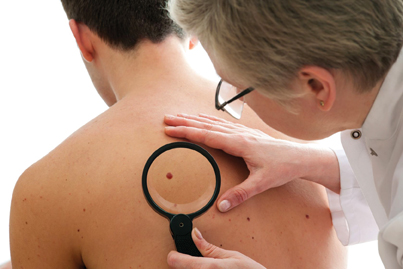Skin Cancer Awareness/Prevention Month
Posted on May 1, 2014 by bob in In Every Life
We are delighted spring weather is finally here, but it reminds us that May is Melanoma/Skin Cancer Detection/Prevention Month. Anyone of any race can develop skin cancer at any age. Three types of skin cancer are: 1) melanoma; 2) basal cell skin cancer; 3) squamous cell skin cancer. Of these, melanoma is most aggressive and can occur on the skin, in the eye, or on mucous membranes.
Symptoms to look for include:
— development of a new/pigmented area on skin, mucus membrane, eye;
— changes in a current mole or birthmark;
— unusual lump or blemish;
— change in the way an area of skin feels.
As with other cancers, when melanoma spreads it often goes to nearby lymph nodes. Early diagnosis is vital. Routine examinations by an ophthalmologist to screen for ocular or intraocular melanoma is important, as are routine screenings by dentists and primary healthcare providers to assess for changes in mucus membranes and skin.
Prevention is key. One modifiable risk factor is past lengthy exposure to sunlight or light from tanning beds. An additional risk factor is a history of blistering sunburns, especially during childhood and teenage years. Avoiding these risks involve individual or parent choices about behaviors.
If you must be outside during the middle of the day, sunscreen, sunglasses, a hat and loosely woven fabrics that cover the arms and legs can be worn to help block the ultraviolet light rays. Another modifiable risk factor for melanoma that can be limited is environmental exposure to radiation (including from X-rays), or chemicals such as solvents or vinyl chloride. Although not always modifiable, a weakened immune system has been associated with melanoma. Efforts to maintain health and immunity are important to limit risk of melanoma formation.
Non-modifiable risk factors include:
–a fair complexion that burns easily/tans poorly;
— light-colored eyes, red or blond hair;
— several moles;
— family history of unusual moles, family/personal history of melanoma;
— genes associated with melanoma.
Although we can’t change heredity or personal history, awareness that these characteristics are linked to higher risk should make those of us with these characteristics more observant. Early identification can mean prompt treatment and a higher likelihood of cure.
As sunshine increases be aware of skin cancer risks, use preventive behaviors, and have screenings for early identification of possible problems. Enjoy your spring!
 Arlene H. Morris, EdD, RN, CNE is Professor of Nursing, Auburn Montgomery School of Nursing. Reach her at amorris@aum.edu.
Arlene H. Morris, EdD, RN, CNE is Professor of Nursing, Auburn Montgomery School of Nursing. Reach her at amorris@aum.edu.
Resources (type “melanoma” in the ‘search box’ of each website):
American Academy of Dermatology — http://www.aad.org/dermatology-a-to-z/
American Cancer Society — http://www.cancer.org/cancer/skincancer-melanoma/
National Cancer Institute — http://www.cancer.gov/cancertopics/









